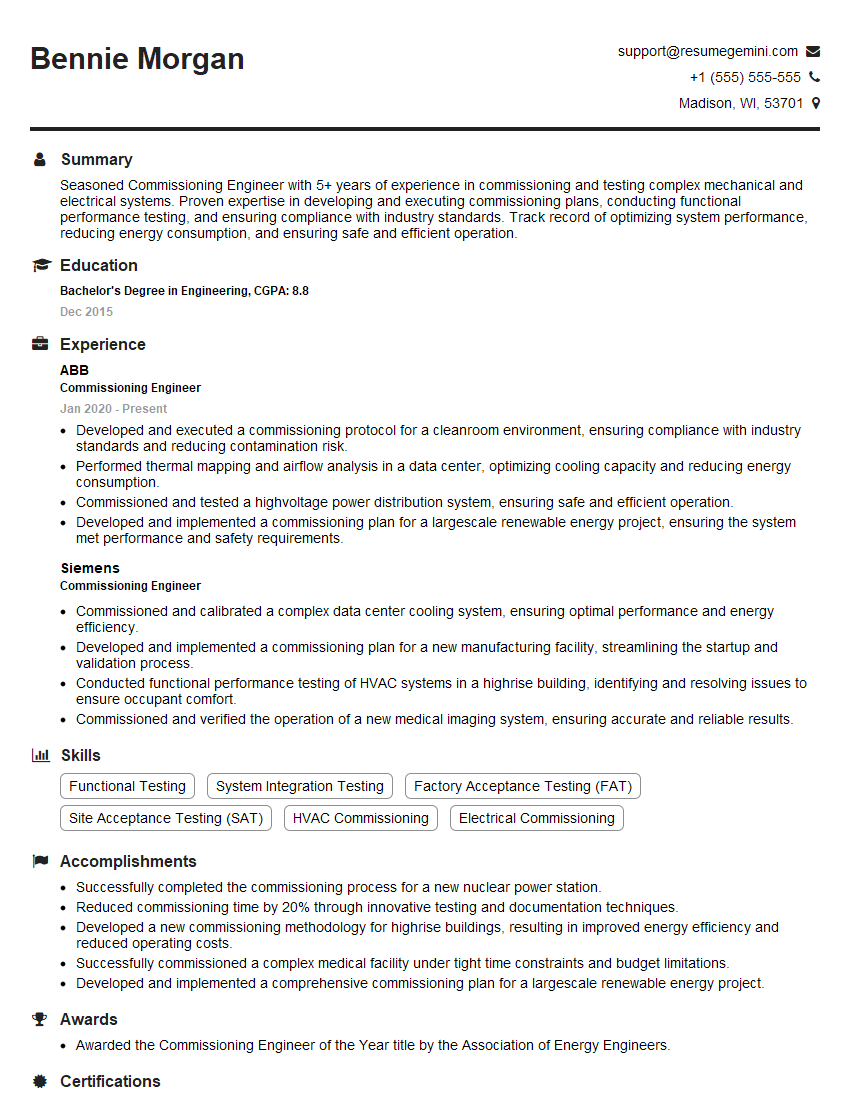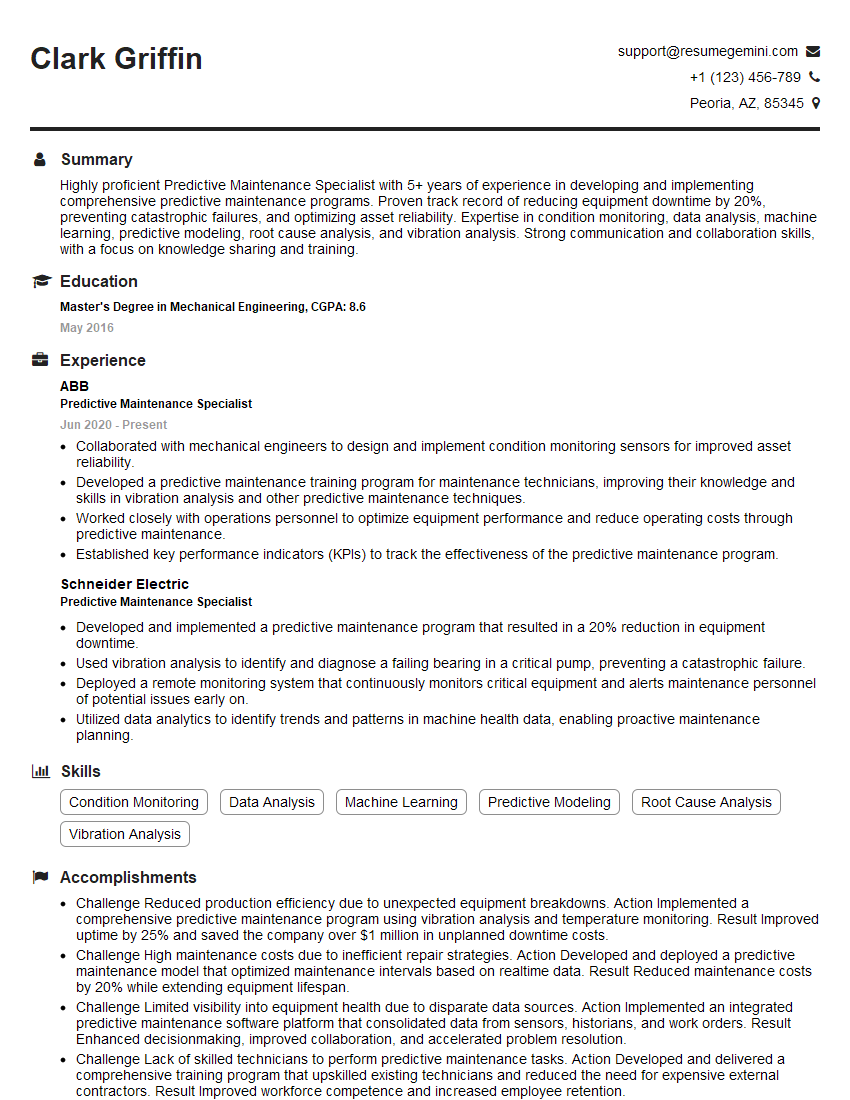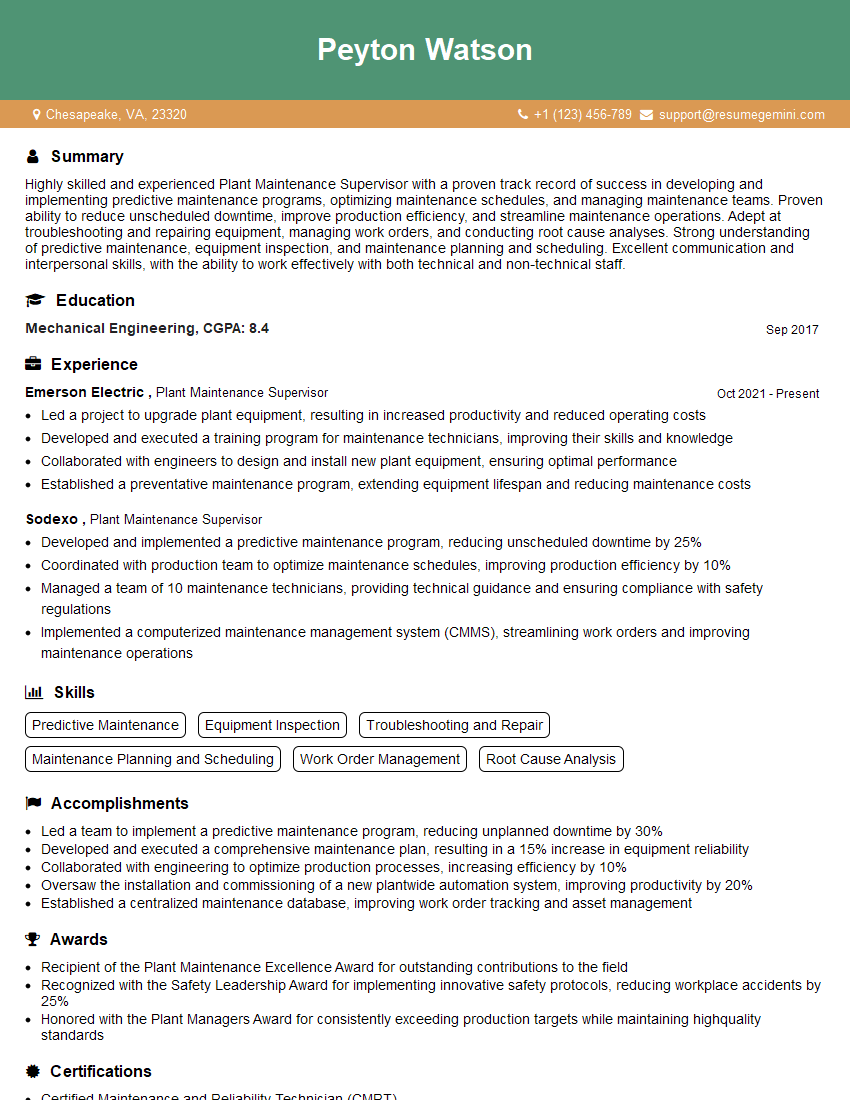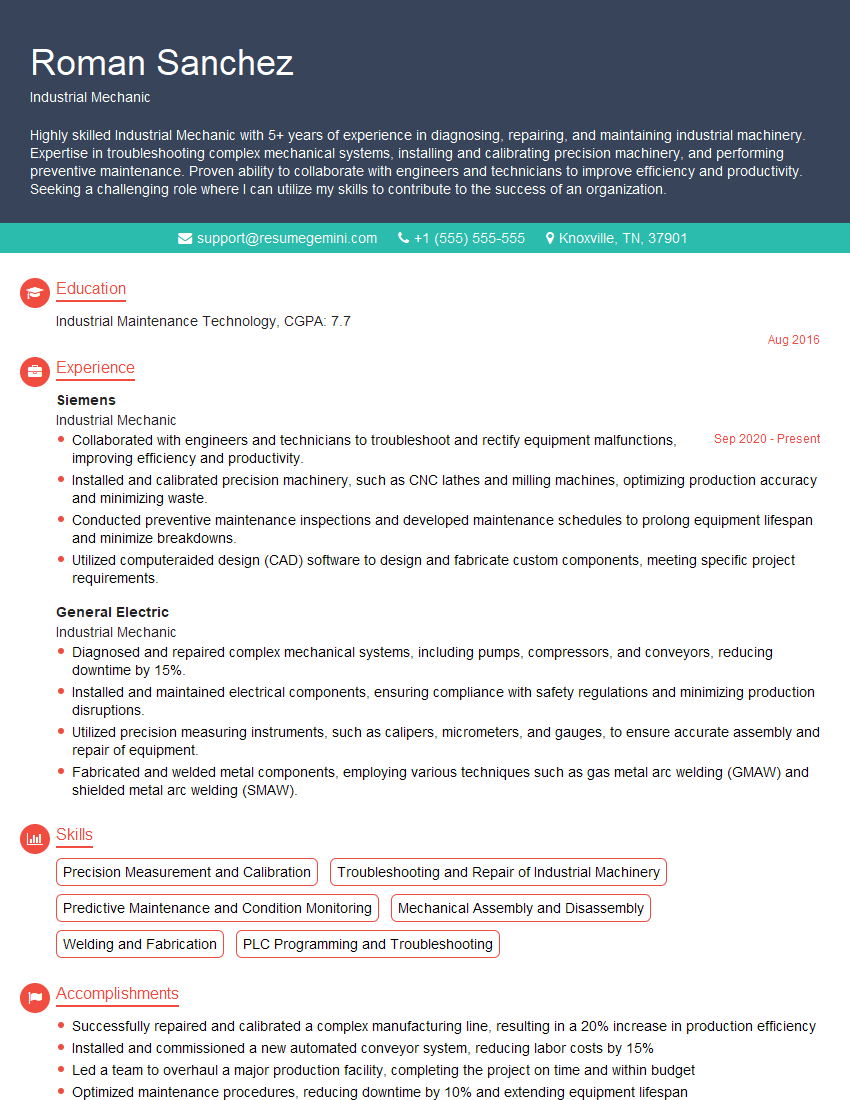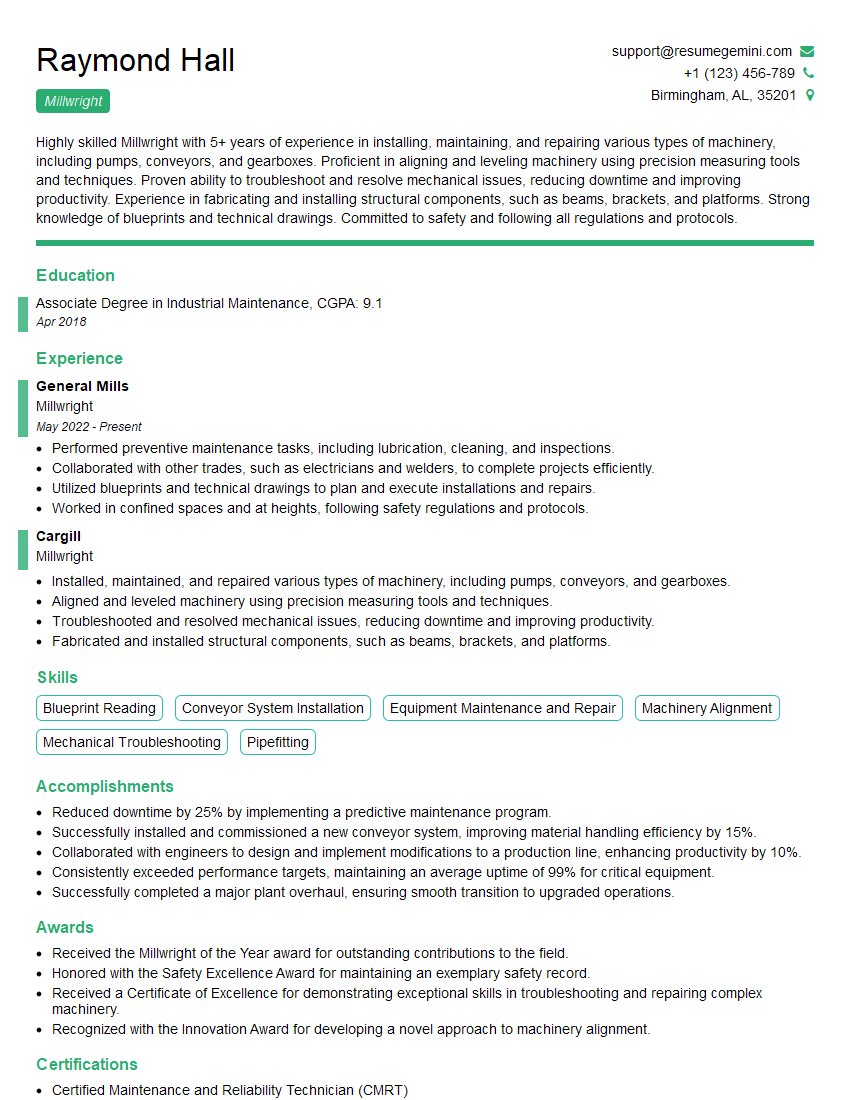Cracking a skill-specific interview, like one for Coupling lubrication, requires understanding the nuances of the role. In this blog, we present the questions you’re most likely to encounter, along with insights into how to answer them effectively. Let’s ensure you’re ready to make a strong impression.
Questions Asked in Coupling lubrication Interview
Q 1. What types of couplings require lubrication?
Not all couplings require lubrication. The need depends heavily on the coupling type and its operating conditions. Generally, couplings with moving parts that experience significant friction during operation need lubrication. This includes many flexible couplings like elastomeric couplings, gear couplings, and diaphragm couplings. Rigid couplings, on the other hand, typically don’t require lubrication as there are no moving parts experiencing significant friction. However, even with rigid couplings, environmental factors (like dust and moisture) might necessitate lubrication for protection.
- Flexible Couplings (requiring lubrication): Elastomeric, Gear, Jaw, Bellows, Universal, Flexible Disc
- Rigid Couplings (typically not requiring lubrication): Flange, Sleeve, Rigid Flange
Q 2. Explain the different types of coupling lubricants and their applications.
Coupling lubricants are specifically formulated to withstand the demanding conditions within a coupling. They vary greatly based on the application. Common types include:
- Grease: A thick, semi-solid lubricant that provides excellent adhesion and long-lasting lubrication in enclosed spaces. It’s widely used for gear couplings and other enclosed types. NLGI grades (National Lubricating Grease Institute) specify the consistency, with higher numbers indicating thicker grease.
- Oil: A liquid lubricant that offers better penetration and cooling capabilities. It’s often used in couplings with high speeds or where good heat dissipation is essential, but might require more frequent application.
- Specialty Lubricants: These are designed for specific conditions, such as high temperatures, extreme pressures, or corrosive environments. For example, a high-temperature grease might be used in a coupling operating near a furnace.
Applications:
The choice depends on the coupling type, speed, operating temperature, environment, and load. A gear coupling, for instance, might use a high-pressure grease, while a high-speed elastomeric coupling might use a specialized oil with excellent shear stability.
Q 3. How do you select the appropriate lubricant for a specific coupling?
Selecting the right lubricant involves considering several key factors:
- Coupling Type: Different couplings have different lubrication requirements. Gear couplings need a thick grease, while a bellows coupling might need a specialized high-temperature grease.
- Operating Conditions: Speed, temperature, load, and environment significantly influence the choice. High-speed applications might require a lower-viscosity oil for reduced friction, while high-temperature applications necessitate a high-temperature grease.
- Manufacturer’s Recommendations: Always consult the coupling manufacturer’s specifications and recommendations. They often specify the type and grade of lubricant best suited for their product.
- Environmental Factors: Consider factors like dust, moisture, and chemicals that might affect the lubricant’s performance. A lubricant with good water resistance might be necessary for outdoor applications.
Think of it like choosing the right clothes for the weather. You wouldn’t wear a winter coat on a summer day. Similarly, you wouldn’t use high-temperature grease in a cold environment.
Q 4. Describe the process of lubricating a flexible coupling.
Lubricating a flexible coupling varies based on its design. Some couplings have built-in lubrication systems (grease fittings or reservoirs), while others require manual lubrication.
For couplings with grease fittings:
- Identify the grease fittings (typically Zerk fittings).
- Use a grease gun to apply the recommended type and quantity of grease until fresh grease is visible at the fitting.
- Wipe away excess grease.
For couplings requiring manual lubrication:
- Consult the manufacturer’s instructions on lubrication points and methods.
- Disassemble the coupling (if necessary) and apply the grease or oil to the designated points.
- Reassemble the coupling.
- Operate the coupling briefly to distribute the lubricant.
Safety is paramount. Always follow safety procedures, wear appropriate safety gear (gloves, eye protection), and ensure the equipment is properly locked out and tagged out before attempting any maintenance.
Q 5. What are the consequences of improper coupling lubrication?
Improper coupling lubrication leads to a range of negative consequences:
- Increased Friction and Wear: This leads to premature wear of coupling components, resulting in reduced efficiency and potentially catastrophic failure.
- Overheating: Friction generates heat, and insufficient lubrication can cause excessive overheating, damaging the coupling and nearby components.
- Reduced Efficiency: Worn or poorly lubricated couplings transmit less power, impacting the overall system performance.
- Vibration and Noise: A lack of lubrication leads to increased vibration and noise, indicating potential problems and potentially damaging other equipment.
- Premature Failure: Ultimately, improper lubrication significantly reduces the lifespan of the coupling, leading to costly replacements and downtime.
Imagine trying to run a bike with no chain lubrication. The friction would cause the chain to wear out quickly, and you would have a very inefficient and noisy ride.
Q 6. How often should couplings be lubricated?
Lubrication frequency depends heavily on factors such as the type of coupling, operating conditions, and the lubricant used.
General Guidelines (Always refer to the manufacturer’s recommendations):
- Gear couplings: May require lubrication every 3-6 months or even annually, depending on load and environment.
- Elastomeric couplings: Often require less frequent lubrication, potentially only once or twice a year, or even less depending on the type and environmental protection.
- Other types: Can vary widely, with some needing lubrication as frequently as monthly. High-temperature or high-load applications usually need more frequent lubrication.
Regular inspection is vital. Rather than sticking to a rigid schedule, check the coupling regularly for signs of wear, overheating, or insufficient lubrication, adjusting the lubrication schedule accordingly. Think of it like preventative car maintenance – regular checks prevent major problems later on.
Q 7. What are the signs of inadequate coupling lubrication?
Several signs indicate inadequate coupling lubrication:
- Increased Vibration: Excessive vibration is a primary indicator. It signifies increased friction and wear.
- Elevated Temperature: High operating temperatures, noticeably hotter than usual, indicate significant frictional heat generation.
- Unusual Noises: Grinding, squealing, or other abnormal noises typically suggest a lack of lubrication and impending failure.
- Leakage: If lubricant is leaking, it might suggest improper lubrication or sealing issues needing attention.
- Stiffness or Difficulty in Rotation: Difficulty in turning the shafts indicates increased friction due to a lack of lubrication.
These are warning signs, just like a check engine light on a car. Addressing them promptly prevents more significant damage and costly repairs down the line.
Q 8. How do you monitor the condition of coupling lubricants?
Monitoring coupling lubricant condition involves a multi-pronged approach, focusing on both visual inspection and analytical testing. Visual checks include assessing the lubricant’s level (ensuring it’s within the manufacturer’s recommended range), color (discoloration can indicate contamination or degradation), and consistency (thinning or thickening suggests potential problems). For example, a milky or cloudy appearance might indicate water ingress. More sophisticated monitoring involves taking lubricant samples for laboratory analysis. This analysis can reveal the presence of contaminants (such as metal particles indicating wear), degradation products, and changes in viscosity, all vital indicators of lubricant health and coupling health. Regular analysis, tied to a preventative maintenance schedule, is crucial for proactive intervention before major failures occur. Imagine a car’s oil – regularly checking its level and condition prevents catastrophic engine damage; similarly, monitoring coupling lubricant helps prevent costly downtime.
Q 9. Explain the importance of lubricant compatibility in coupling systems.
Lubricant compatibility is paramount in coupling systems because incompatible lubricants can lead to a variety of problems, including chemical reactions that degrade the lubricant, seal swelling or damage, and ultimately coupling failure. Different lubricant types (mineral oil, synthetic oil, grease) have different chemical compositions and properties. Mixing them can create sludge, reduce lubrication effectiveness, and even cause corrosion of coupling components. For instance, mixing a synthetic ester-based lubricant with a mineral oil-based lubricant might lead to the formation of an emulsion, significantly reducing the lubricant’s lubricating properties. Therefore, always adhere strictly to the manufacturer’s recommendations for lubricant type and never mix different lubricants unless specifically permitted.
Q 10. What are the common failure modes of couplings related to lubrication?
Common coupling failure modes linked to poor lubrication include excessive wear, seizing, fretting corrosion, and premature component fatigue. Excessive wear occurs when insufficient lubrication leads to increased friction between moving parts, resulting in the gradual erosion of surfaces. Seizing is a more catastrophic failure where the lack of lubrication causes metal-to-metal contact, leading to the components becoming locked together. Fretting corrosion is a form of localized wear and corrosion typically occurring at the interface of tightly clamped surfaces, exacerbated by inadequate lubrication and vibration. Premature fatigue is also accelerated by insufficient lubrication due to increased cyclic stresses and friction. In each of these cases, preventative maintenance, including regular lubricant checks and replacements according to the manufacturer’s recommendations, is crucial in preventing these failures.
Q 11. How do you troubleshoot a coupling that is exhibiting excessive wear or noise?
Troubleshooting a coupling with excessive wear or noise involves a systematic approach. First, visually inspect the coupling for obvious signs of damage, such as cracks, scoring, or misalignment. Check the lubricant level and condition. If the lubricant is low, contaminated, or degraded, that’s a likely culprit. Next, investigate for misalignment – even slight misalignment can drastically increase wear and noise. Use alignment tools to assess the coupling’s alignment precisely. If misalignment is found, correct it. If the problem persists, the coupling might require disassembly for a more thorough inspection. Examine the individual components (e.g., gears, splines) for wear or damage. Measure wear patterns to determine the root cause of the excessive wear. Sometimes, replacing worn components is necessary. A systematic approach that considers lubrication, alignment, and component wear is needed to resolve the issue.
Q 12. Describe the procedure for inspecting a coupling for proper lubrication.
Inspecting a coupling for proper lubrication involves several steps. First, visually check the lubricant level using a dipstick or sight glass, if available. Ensure the level is within the manufacturer’s specified range. Assess the lubricant’s appearance: look for discoloration, unusual consistency, or the presence of contaminants (metal particles, water). If the coupling has lubrication fittings (grease zerks), inspect them for proper function. Try to check the grease pressure or lubrication flow, if possible. Observe the coupling’s operation, noting any unusual sounds or vibrations (excessive noise suggests poor lubrication). Finally, consider the surrounding environment. Excessive dust or dirt can contaminate the lubricant. Document all your observations to maintain a record of the coupling’s condition and planned maintenance.
Q 13. What safety precautions should be taken when lubricating couplings?
Safety precautions during coupling lubrication are vital. Always use appropriate personal protective equipment (PPE), including safety glasses, gloves, and potentially hearing protection depending on the equipment. Never lubricate a coupling while it’s running. Ensure the coupling is properly isolated and locked out before performing any maintenance. Be aware of potential hazards like hot surfaces, moving parts, and high-pressure systems. Follow the manufacturer’s safety guidelines closely. Use the correct lubricant and tools, and dispose of used lubricant properly to comply with environmental regulations. Proper handling of lubricants minimizes risks of spills, skin contact, and environmental contamination.
Q 14. How do you determine the correct amount of lubricant to use?
Determining the correct amount of lubricant depends entirely on the coupling’s design, type, and manufacturer’s recommendations. The manufacturer’s instructions should always be the primary source of information. These instructions often specify the lubricant type, viscosity, and the quantity needed. Sometimes, there will be level indicators or sight glasses to help visually assess the lubricant level. For grease lubricated couplings, the amount of grease added is typically determined by the number of pumps or cycles on a grease gun until the grease appears at the coupling seal points. Using too little lubricant leads to insufficient lubrication and wear. Using too much can result in seal damage or even lubricant leakage. Always follow the manufacturer’s guidance strictly.
Q 15. What are the environmental considerations related to coupling lubrication?
Environmental considerations in coupling lubrication are paramount. We must minimize the impact of lubricant spills or leaks on the surrounding environment. This includes considering the lubricant’s:
- Biodegradability: Choosing biodegradable lubricants reduces the long-term harm to soil and water if a leak occurs. Many environmentally friendly options are available now, often derived from vegetable oils.
- Toxicity: The lubricant’s toxicity to aquatic life and terrestrial organisms is crucial. Data sheets should be reviewed to assess potential environmental hazards.
- Disposal: Proper disposal methods are vital, often involving specialized waste collection services for used lubricating oils or greases. Improper disposal can lead to significant environmental contamination.
- Air emissions: Some lubricants, particularly those containing volatile organic compounds (VOCs), can contribute to air pollution during application or leakage. Low-VOC lubricants should be preferred.
For example, a coupling located near a water source requires extra care in lubricant selection and leak prevention measures. Regular inspections and leak detection systems are essential in sensitive environmental areas.
Career Expert Tips:
- Ace those interviews! Prepare effectively by reviewing the Top 50 Most Common Interview Questions on ResumeGemini.
- Navigate your job search with confidence! Explore a wide range of Career Tips on ResumeGemini. Learn about common challenges and recommendations to overcome them.
- Craft the perfect resume! Master the Art of Resume Writing with ResumeGemini’s guide. Showcase your unique qualifications and achievements effectively.
- Don’t miss out on holiday savings! Build your dream resume with ResumeGemini’s ATS optimized templates.
Q 16. Explain the difference between grease and oil lubrication for couplings.
The choice between grease and oil lubrication for couplings depends heavily on the operating conditions and the coupling type.
- Grease: Grease is thicker and provides better adhesion, making it ideal for applications with slow speeds and low operating temperatures. It offers excellent sealing properties, preventing leakage and protecting against contaminants. However, grease can be difficult to pump and may not adequately lubricate high-speed, high-temperature applications.
- Oil: Oil is thinner and flows more readily, enabling better lubrication at higher speeds and temperatures. It’s also more efficient at dissipating heat. Oil lubrication systems often require more sophisticated delivery methods and more frequent maintenance than grease lubrication due to potential leaks. Oil-based systems are generally better for couplings operating under heavy loads and high speeds.
Imagine a slow-moving conveyor belt coupling – grease would likely be sufficient. Conversely, a high-speed gear coupling in a turbine requires oil for effective cooling and lubrication. The wrong choice can lead to premature coupling failure.
Q 17. How do you address lubricant leaks from couplings?
Addressing lubricant leaks from couplings requires a systematic approach:
- Identify the source: Carefully inspect the coupling and its seals for cracks, wear, or damage. Look for signs of excessive wear, misalignment, or improper installation.
- Repair or replace seals: Replace damaged seals or consider upgrading to higher-quality seals with improved resistance to wear and tear. Ensure correct seal selection based on the chosen lubricant and operating conditions.
- Tighten connections: Ensure all bolts and fittings are securely tightened to prevent leaks from loose connections.
- Improve lubrication system design: If leaks persist, consider upgrading to a system with improved leak prevention features, such as a better quality pump or improved seal design.
- Regular maintenance: Implement a routine inspection and maintenance schedule to catch potential leaks early on before they become major problems.
For instance, a persistent leak might indicate worn-out shaft seals requiring replacement. Ignoring leaks can lead to environmental contamination, costly repairs and premature component failure.
Q 18. What are the advantages and disadvantages of automatic lubrication systems for couplings?
Automatic lubrication systems offer several advantages:
- Reduced maintenance: They eliminate the need for manual lubrication, saving time and labor.
- Improved reliability: Consistent lubrication reduces wear and tear, extending coupling lifespan.
- Optimized lubrication: They deliver the precise amount of lubricant needed, preventing over- or under-lubrication.
- Environmental benefits: They can reduce lubricant waste and potential spills.
However, automatic systems also have drawbacks:
- Higher initial cost: The upfront investment is higher compared to manual lubrication.
- Increased complexity: They require more sophisticated installation and potentially specialized maintenance.
- Potential for malfunctions: System failure can lead to lubrication issues, requiring rapid intervention.
The decision to implement an automatic system should be based on a cost-benefit analysis, considering factors like coupling criticality, maintenance costs, and environmental concerns. For example, a critical coupling in a power plant may benefit from an automatic system to ensure consistent reliability despite its higher initial investment.
Q 19. How do you handle disposal of used coupling lubricants?
Disposal of used coupling lubricants must adhere to local environmental regulations. It’s crucial to prevent environmental contamination. Used lubricants are generally considered hazardous waste. Therefore:
- Collect and contain: Used lubricant should be collected in properly labeled containers to prevent spills or accidental mixing with other materials.
- Proper labeling: Containers must be clearly labeled with the type of lubricant and hazard warnings.
- Recycle or dispose: Contact a licensed hazardous waste disposal company to recycle or dispose of the used lubricant according to regulations. Many companies specialize in reclaiming used oil for reuse.
- Record keeping: Maintain detailed records of lubricant usage, disposal methods, and the disposal company’s documentation.
Improper disposal can result in hefty fines and environmental damage. Always prioritize compliance and work with approved disposal professionals.
Q 20. What are the key parameters to consider when specifying a coupling lubricant?
Specifying a coupling lubricant requires careful consideration of several parameters:
- Viscosity: The lubricant’s viscosity determines its flow rate at a given temperature. It must be appropriate for the operating temperature range and coupling speed.
- Temperature range: The lubricant should maintain its desired viscosity throughout the expected operating temperature range.
- Base oil type: Mineral oils, synthetic oils, or biodegradable oils have different properties and environmental impacts. The selection depends on specific needs and environmental considerations.
- Additives: Additives like extreme-pressure (EP) agents, anti-wear agents, and rust inhibitors enhance lubricant performance and extend its lifespan.
- Compatibility: Ensure compatibility between the lubricant and the coupling materials to prevent material degradation or swelling.
- NLGI grade (for greases): This indicates the grease’s consistency. The selection depends on the coupling’s speed and operating conditions.
Failing to consider these parameters can lead to premature coupling wear, increased friction, and potential equipment failure.
Q 21. Explain the relationship between coupling lubrication and vibration.
Coupling lubrication plays a vital role in minimizing vibration. Insufficient or improper lubrication increases friction, leading to increased heat generation and vibration. This can cause premature wear of the coupling components and even lead to catastrophic failure.
Conversely, proper lubrication minimizes friction, reducing vibration and extending the operational life of the coupling. The lubricant acts as a cushion, damping vibrations and protecting against shock loads. The viscosity of the lubricant and its ability to maintain its properties at operating temperatures are crucial factors in vibration reduction. Regular inspection, proper lubrication, and coupling alignment are essential in minimizing vibration and maximizing lifespan.
For example, increased vibration in a coupling might indicate a lubrication problem, prompting a check of the lubricant level, quality and the need for replacement. Regular vibration monitoring can aid in detecting lubrication issues before they cause major problems.
Q 22. How does temperature affect coupling lubricant performance?
Temperature significantly impacts coupling lubricant performance. Think of it like this: lubricants are essentially designed to maintain a specific viscosity (thickness) to provide optimal lubrication within a certain temperature range. High temperatures can thin the lubricant, reducing its film strength and leading to increased friction, wear, and potential failure. Conversely, extremely low temperatures can thicken the lubricant, making it difficult to pump and potentially causing it to lose its lubricating properties, leading to sluggish operation or even seizing.
For example, a grease designed for moderate temperatures may become too thin in hot climates, leading to increased wear on the coupling components. Similarly, a lubricant optimized for high temperatures could become excessively thick in cold conditions hindering its ability to reach all contact surfaces.
Manufacturers provide operating temperature ranges for their lubricants. Staying within these limits is crucial for long coupling lifespan and efficient operation. Choosing a lubricant with the correct viscosity grade is crucial based on the anticipated operating temperature and load.
Q 23. What are the effects of contamination on coupling lubricants?
Contamination is the enemy of coupling lubricants. Even small amounts of contaminants like water, dust, or metal particles can drastically reduce the lubricant’s effectiveness and accelerate wear. Water, for instance, can emulsify grease, breaking down its structure and reducing its ability to lubricate. Dust and dirt act as abrasives, increasing wear on coupling components. Metal particles from wear within the coupling itself can exacerbate the problem, creating a vicious cycle of further wear and damage.
Imagine adding sand to engine oil; the sand particles would act as abrasive agents, scratching engine parts. Similarly, contaminants in coupling lubricants degrade their performance and shorten coupling lifespan. Regular maintenance, including filtration and lubricant analysis, is vital for minimizing contamination.
The consequences of contamination include increased friction, accelerated wear, premature lubricant degradation, and ultimately, coupling failure. Proper sealing, clean handling procedures, and regular lubrication maintenance are vital for minimizing contamination.
Q 24. Describe different methods of coupling lubrication, such as manual, automated, and centralized systems.
Coupling lubrication methods vary depending on factors like coupling type, size, accessibility, and operational requirements.
- Manual Lubrication: This involves manually applying lubricant (grease or oil) using a grease gun or oil can at predetermined intervals. It’s simple and inexpensive but requires regular attention and can be labor-intensive, especially for numerous couplings. It’s suitable for less critical, easily accessible couplings.
- Automated Lubrication: This employs automated systems like grease pumps or lubricators that deliver lubricant to the coupling at set intervals or based on operating parameters. It’s ideal for hard-to-reach couplings or where regular manual lubrication is impractical. This ensures consistent lubrication and reduces maintenance time.
- Centralized Lubrication Systems: These systems deliver lubricant to multiple points, including couplings, from a central source. They’re used for large-scale operations with many couplings or in situations demanding precise control over lubrication. They provide a high degree of automation and oversight, offering efficient lubrication management across a network of machinery.
The choice of lubrication method depends on the specific application and priorities. Consider factors like maintenance costs, labor needs, coupling criticality, and environmental factors when making your decision.
Q 25. How do you interpret a lubrication chart for couplings?
A lubrication chart for couplings typically provides recommendations on lubricant type, quantity, and frequency of lubrication based on factors such as coupling type, size, operating speed, temperature, and load. Think of it as a roadmap for maintaining your coupling’s health.
Interpreting the chart involves identifying your specific coupling’s parameters (e.g., type, size, operating conditions) and then cross-referencing those parameters against the chart’s recommendations. The chart will usually specify the appropriate NLGI grease grade or oil viscosity, the amount of lubricant to be applied (e.g., grams or ounces), and the frequency of lubrication (e.g., daily, weekly, monthly).
For example, a chart might indicate that a specific coupling operating under high speed and temperature requires a high-temperature grease with an NLGI grade 2, applied every two weeks, at a quantity of 50 grams. Always follow the manufacturer’s recommendations strictly for optimal performance.
Q 26. What is the role of NLGI grease grades in coupling lubrication?
NLGI (National Lubricating Grease Institute) grease grades represent the consistency or hardness of a grease. The scale ranges from 000 (very soft) to 6 (very hard). The number indicates the grease’s penetration, which signifies its ability to flow and be pumped. This is crucial for coupling lubrication because the grade selection affects how easily the grease is distributed within the coupling.
For couplings, the choice of NLGI grade depends on the application. Higher NLGI numbers (harder greases) are better suited for applications with high operating temperatures or high loads, as they provide a thicker, more durable lubricant film that can withstand the conditions. Conversely, lower NLGI grades (softer greases) are better for low-temperature and/or lower-load situations, allowing easier distribution and improved lubrication in those applications.
Selecting the incorrect NLGI grade can lead to inadequate lubrication or excessive grease leakage, both of which can harm the coupling. Always consult the manufacturer’s recommendations for your coupling and operational conditions.
Q 27. How do you ensure proper lubrication during coupling installation and maintenance?
Proper lubrication during coupling installation and maintenance is paramount for longevity and operational efficiency. During installation, ensure all coupling components are clean and free of debris before applying lubricant. Use the recommended lubricant type and quantity specified by the manufacturer or lubrication chart.
For example, before installing a new coupling, clean all mating surfaces thoroughly and then apply a thin layer of grease to the coupling’s moving parts. After installation, follow the lubrication schedule and method outlined in the manual or lubrication chart. This might involve adding grease through zerk fittings using a grease gun or adding oil to oil reservoirs.
During maintenance, regularly inspect the coupling for signs of lubricant leakage, contamination, or wear. Clean the coupling as needed, and reapply lubricant according to the recommended schedule. Proper sealing of the coupling is vital to prevent lubricant leakage and contamination.
Q 28. Explain the importance of keeping lubrication records for couplings.
Maintaining accurate lubrication records for couplings is essential for several reasons. It provides a history of lubrication activities, allowing for trend analysis and predictive maintenance. This assists in identifying potential issues early on, preventing costly downtime and unexpected failures. Records also serve as a vital tool for complying with industry regulations and safety standards.
The records should include dates of lubrication, type and quantity of lubricant used, the method of application, and any observations made during the lubrication process (e.g., leaks, unusual wear). These records are invaluable for troubleshooting issues, supporting warranty claims, and demonstrating compliance with safety and maintenance standards.
Consider using a digital system to manage these records for better organization and accessibility. For instance, a software application or spreadsheet could track all coupling lubrication details effectively. Regular review of these records, perhaps annually, is crucial for identifying potential problems and improving lubrication strategies.
Key Topics to Learn for Coupling Lubrication Interview
- Types of Couplings and Lubricants: Understanding the various coupling types (rigid, flexible, fluid) and the appropriate lubricants for each, considering factors like operating speed, temperature, and load.
- Lubrication Methods and Schedules: Familiarize yourself with different lubrication methods (grease, oil, oil mist) and the importance of establishing effective lubrication schedules based on operating conditions and manufacturer recommendations. This includes understanding the implications of improper lubrication intervals.
- Lubricant Selection and Properties: Learn the key properties of lubricants (viscosity, shear strength, oxidation resistance) and how to select the optimal lubricant for specific coupling applications. Consider the impact of environmental factors on lubricant performance.
- Failure Analysis and Troubleshooting: Develop your ability to diagnose common coupling lubrication-related issues, such as premature wear, excessive heat generation, and lubricant leakage. Understand the root causes and preventative measures.
- Safety Procedures and Regulations: Understand relevant safety protocols and regulations related to handling lubricants and working with rotating machinery. This includes proper personal protective equipment (PPE) usage.
- Maintenance Practices and Documentation: Become familiar with best practices for coupling lubrication maintenance, including proper cleaning, inspection techniques, and accurate record-keeping.
- Advanced Lubrication Technologies: Explore advanced lubrication technologies, such as automatic lubrication systems and condition monitoring techniques, to demonstrate a forward-thinking approach.
Next Steps
Mastering coupling lubrication is crucial for advancing your career in maintenance, engineering, or related fields. A strong understanding of this critical area demonstrates your practical skills and commitment to operational efficiency. To significantly boost your job prospects, create an ATS-friendly resume that highlights your expertise. ResumeGemini is a trusted resource to help you build a professional and impactful resume that stands out to recruiters. Examples of resumes tailored to coupling lubrication expertise are available within ResumeGemini to guide you. Take the next step toward your career goals – craft a compelling resume that showcases your knowledge and experience.
Explore more articles
Users Rating of Our Blogs
Share Your Experience
We value your feedback! Please rate our content and share your thoughts (optional).
What Readers Say About Our Blog
Hello,
We found issues with your domain’s email setup that may be sending your messages to spam or blocking them completely. InboxShield Mini shows you how to fix it in minutes — no tech skills required.
Scan your domain now for details: https://inboxshield-mini.com/
— Adam @ InboxShield Mini
Reply STOP to unsubscribe
Hi, are you owner of interviewgemini.com? What if I told you I could help you find extra time in your schedule, reconnect with leads you didn’t even realize you missed, and bring in more “I want to work with you” conversations, without increasing your ad spend or hiring a full-time employee?
All with a flexible, budget-friendly service that could easily pay for itself. Sounds good?
Would it be nice to jump on a quick 10-minute call so I can show you exactly how we make this work?
Best,
Hapei
Marketing Director
Hey, I know you’re the owner of interviewgemini.com. I’ll be quick.
Fundraising for your business is tough and time-consuming. We make it easier by guaranteeing two private investor meetings each month, for six months. No demos, no pitch events – just direct introductions to active investors matched to your startup.
If youR17;re raising, this could help you build real momentum. Want me to send more info?
Hi, I represent an SEO company that specialises in getting you AI citations and higher rankings on Google. I’d like to offer you a 100% free SEO audit for your website. Would you be interested?
Hi, I represent an SEO company that specialises in getting you AI citations and higher rankings on Google. I’d like to offer you a 100% free SEO audit for your website. Would you be interested?
good
